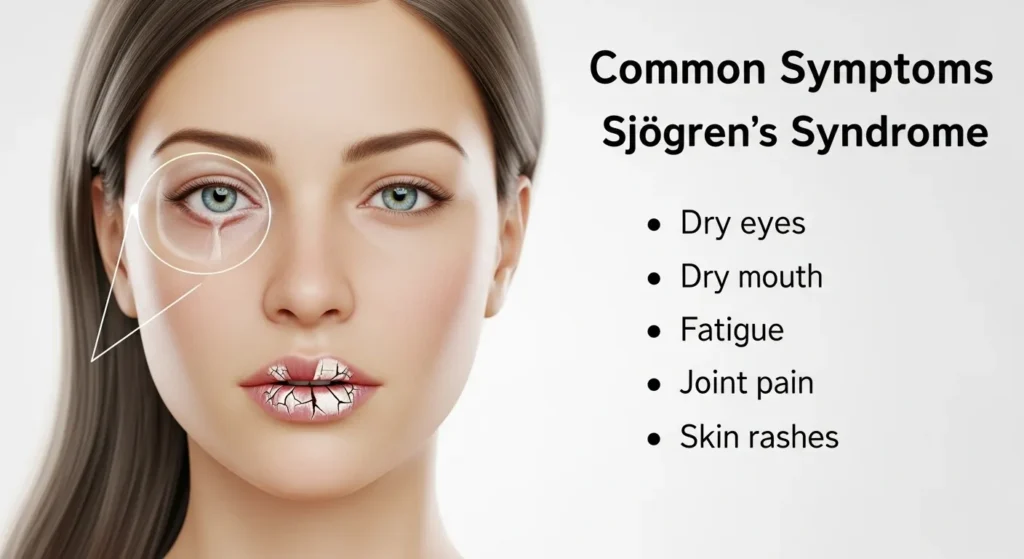Hair thinning or sudden hair loss can be alarming, especially if you’re already managing a chronic condition like Sjögren’s syndrome. While this autoimmune disease is often associated with dry eyes and mouth, it can also trigger unexpected hair loss.
In this guide, we explore the connection between Sjögren’s syndrome and hair loss, the types of shedding involved, and the best treatment options available. Learn how to recognize symptoms, manage hair thinning effectively, and get expert-backed advice to restore both your hair and confidence.
What Is Sjögren’s Syndrome?

Sjögren’s syndrome is a chronic autoimmune disorder where the immune system mistakenly attacks the body’s moisture-producing glands, primarily the salivary and tear glands.
Overview of the Autoimmune Condition
- Commonly affects middle-aged women, especially those aged 40–60.
- Often occurs alongside other autoimmune diseases like rheumatoid arthritis or lupus.
Common Symptoms
- Dry eyes and dry mouth (the hallmark symptoms)
- Fatigue
- Joint pain
- Skin dryness
- Vaginal dryness
- Hair thinning or loss (less frequently discussed but significant)
Who Is at Risk?
- Women are nine times more likely to develop Sjögren’s than men.
- Individuals with a family history of autoimmune diseases.
- People with other autoimmune disorders are at greater risk.
Can Sjögren’s Syndrome Cause Hair Loss?
Yes, Sjögren’s syndrome can contribute to hair loss, although the relationship is complex.
Understanding Autoimmune-Related Hair Loss
Autoimmune conditions like Sjögren’s may trigger an immune response that targets hair follicles, causing inflammation and disrupted growth cycles.
Inflammation and Damage to Hair Follicles
Chronic inflammation interferes with normal hair growth. The immune system can mistakenly identify hair follicles as a threat and attack them.
Direct vs. Indirect Causes
- Direct: Immune-mediated damage to hair follicles.
- Indirect:
- Side effects of immunosuppressive medications.
- Nutrient deficiencies are due to poor absorption.
- Chronic stress and fatigue.
- Hormonal imbalance.
What Type of Hair Loss Is Linked to Sjögren’s Syndrome?
Different types of hair loss may appear in people with Sjögren’s, depending on how the condition affects their body.
Telogen Effluvium
- Often stress-induced.
- Causes diffuse thinning or increased shedding.
- Usually reversible with proper treatment.
Alopecia Areata
- An autoimmune condition that causes patchy bald spots.
- Hair may regrow, but it often relapses.
Diffuse Thinning
- Thinning across the entire scalp, not in distinct patches.
- May be due to chronic inflammation or poor scalp health.
How to Recognize Hair Loss Due to Sjögren’s Syndrome
Early identification allows for more effective treatment.
Early Warning Signs
- Increased hair fall in the shower or on your pillow.
- Thinner ponytail or visible scalp areas.
- Scalp discomfort or tightness.
Scalp Sensitivity or Inflammation
- Tenderness when brushing.
- Red, dry, or flaky patches.
- May resemble psoriasis or dermatitis.
When to Consult a Specialist
- If hair loss is sudden, severe, or accompanied by other Sjögren’s symptoms.
- Seek help from a dermatologist or rheumatologist.
Diagnosis and Tests
Proper diagnosis ensures your hair loss is treated at its root cause.
Blood Tests
- ANA (antinuclear antibody)
- SSA/Ro and SSB/La antibodies
- ESR or CRP (inflammatory markers)
Scalp Biopsy or Trichoscopy
- Examines scalp health and hair follicle condition.
- Helps distinguish autoimmune-related hair loss from other types.
Differential Diagnosis
- Rules out thyroid issues, iron deficiency, or other autoimmune diseases like lupus or psoriasis.
Treatment Options for Hair Loss from Sjögren’s Syndrome
Treatment depends on the underlying cause and severity.
Managing the Underlying Autoimmune Disease
- Immunosuppressants like hydroxychloroquine or methotrexate may be prescribed.
- Corticosteroids during flares.
Topical Solutions & Hair Restoration Therapies
- Minoxidil (Rogaine) to stimulate regrowth.
- Anti-inflammatory scalp treatments.
- Gentle hair care products for sensitive scalps.
Advanced Therapies
- PRP (Platelet-Rich Plasma) injections to promote follicle health.
- Low-Level Laser Therapy (LLLT) under medical supervision.
Lifestyle and Nutritional Tips
Supporting your body from the inside out can improve hair recovery.
Anti-Inflammatory Diet
- Focus on omega-3s, leafy greens, berries, and whole grains.
- Avoid processed foods, sugar, and dairy if sensitive.
Stress Management and Sleep
- Chronic stress worsens autoimmune flares and hair loss.
- Practice yoga, mindfulness, or cognitive therapy.
Helpful Supplements
- Vitamin D, Iron, Biotin, Omega-3s
- Always consult your physician before starting supplements.

Expert Advice and Patient Experiences
What Dermatologists and Rheumatologists Recommend
- Regular follow-ups to monitor autoimmune activity.
- Personalized plans combining systemic and topical treatments.
Importance of Multidisciplinary Care
- Collaborative care between dermatology, rheumatology, and nutrition can maximize hair regrowth outcomes.
When to See a Specialist
- Noticeable thinning or bald patches
- Persistent scalp irritation
- New onset of hair loss with other autoimmune symptoms
Consult a dermatologist or rheumatologist to ensure comprehensive care
FAQs About Sjögren’s Syndrome and Hair Loss
Is hair loss permanent in Sjögren’s syndrome?
Not always. Many cases are reversible with early diagnosis and appropriate treatment.
Can hair grow back with treatment?
Yes. Once inflammation is managed, follicles can resume normal growth.
What are the best shampoos or products to use?
Use sulfate-free, gentle products made for sensitive or inflamed scalps.
Are there natural remedies that help?
While some find success with aloe vera or coconut oil, medical treatment is key.
Take Your Next Step
Concerned about hair loss from Sjögren’s syndrome?
Book a consultation with Dr. Rana Irfan in Islamabad to explore safe, customized treatments that restore your hair health and manage your autoimmune symptoms effectively.
